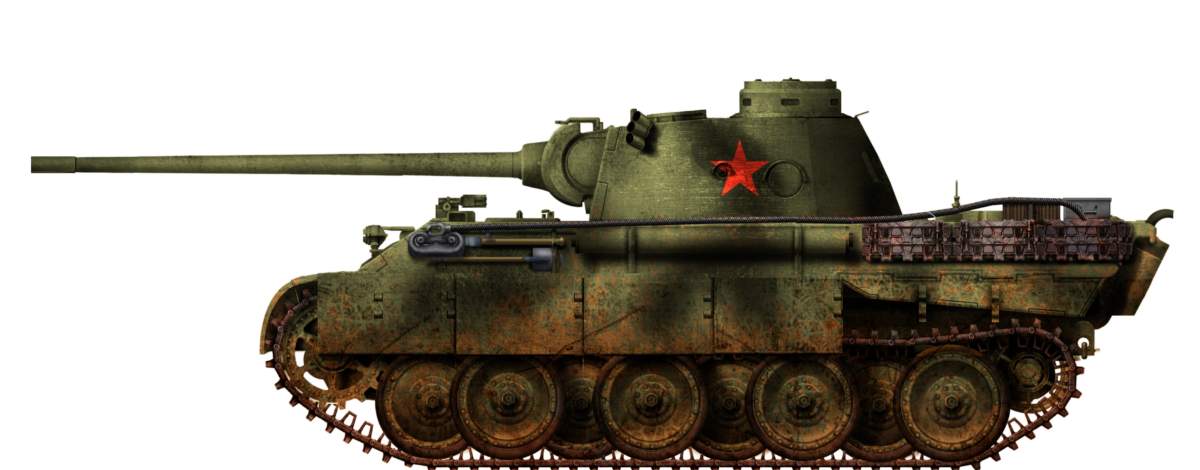 Soviet Union (1944-1945)
Soviet Union (1944-1945)
Medium Tank – None Built
One of the most recognizable tanks of the Third Reich was the Panzerkampfwagen V “Panther”. Created as a replacement for the medium Panzer III and Panzer IV tanks and as a “response” to the Soviet KV and T-34, the Panther was a formidable opponent on the battlefield. A powerful and rapid-firing gun, good aiming devices for the crew, and strong frontal armor made the vehicle excellent in both defensive and offensive operations. Panthers captured by the Red Army were highly valued. During the war, Soviet troops captured a significant number of serviceable or damaged, but recoverable Pz.Kpfw.Vs, and even combat units of the Red Army were created on their basis. The option of rearming them with “domestic” guns was also considered, however, the T-V-85 appeared too late, and the end of the war left it no chance of appearing in reality.
The Medium Cat of the Wehrmacht
The first considerations for a new medium tank which could replace the Panzer III and Panzer IV appeared in 1938, with the VK20 project series, a fully tracked vehicle weighing ~20 tonnes. Design proposals by Daimler Benz, Krupp, and MAN ensued, but soon, these designs were abandoned and Krupp dropped out of the competition entirely. The requirements increased to a vehicle weighing 30 tonnes as a reaction to the encounters with the Soviet T-34 and KV-1 tanks.
At the insistence of General Heinz Guderian, a special tank commission was created to assess the T-34. Among the features of the Soviet tank considered most significant were the sloping armor, which gave much improved shot deflection and also increased the effective armor thickness against penetration that could be achieved with thinner plates, the wide tracks, which improved mobility over soft ground; and the 76 mm gun, which had good armor penetration and also fired an effective high-explosive round. All this outclassed the existing models of the German Panzer III and IV. Daimler-Benz (DB), which had designed the successful Panzer III and StuG III, and Maschinenfabrik Augsburg-Nürnberg AG (MAN) were given the task of designing a new 30- to 35-tonne tank, designated VK 30, by April 1942.
MAN’s design won the competition, despite DB’s one having several advantages and having the admiration of the Reich’s Ministers for Armaments and Munitions, Fritz Todd and his successor, Albert Speer. One of the principal reasons given for this decision was that the MAN design used an existing turret designed by Rheinmetall-Borsig, while the DB design would have required a brand new turret and engine to be designed and produced, delaying the mass production of the vehicle.

Source: Zinoviy Alexeev Design Bureau, drawn by Andrej Sinyukovich.
The initial production target was 250 tanks per month at the MAN plant at Nuremberg. The first production Panther tanks were designated Panther Ausf.D, not Ausf.A. Later production targets were increased to 600 per month in January 1943. Despite determined efforts, this figure was never reached due to disruption by Allied bombing, and manufacturing and resource bottlenecks. Production in 1943 averaged 148 tanks per month. In 1944, it averaged 315 a month, with 3,777 built throughout the year. Monthly production peaked at 380 in July 1944. Production ended around the end of March 1945, with at least 6,000 built in total. A Panther tank cost 117,100 Reichsmark (~US$60 mln in 2022) to produce.
Panther in Soviet Use

By the middle of 1943, the Red Army already had experience in operating the PzKpfw.38 (t), PzKpfw.II, PzKpfw.III, and PzKpfw.IV, as well as self-propelled guns based on them. However, the use of Pz.Kpfw.V was a very difficult task, requiring appropriate training of crews and the availability of a repair base. Soviet tankers, lacking necessary experience in operating such complex and foreign equipment, often disabled Panthers after driving 15–20 km, and then could not repair them due to the lack of necessary spare parts, tools, and the experience in repairing such vehicles.

The headquarters of the 4th Guards Tank Army reported to the GBTU of the Red Army:
“These tanks (Pz.Kpfw.V) are difficult to operate and repair. There are no spare parts for them, which leaves no chance for their maintenance.
To fuel the tanks, it is necessary to provide for an uninterrupted supply of high-quality aviation gasoline. In addition, there are big problems with ammunition for the German 75 mm tank gun mod. 1942 (Kw.K. 42), since the ammunition from the gun mod. 1940 (Kw.K.40) is unsuitable for the Panther tank.
We believe that a German tank of the Pz.Kpfw. IV type is more suitable for carrying out offensive operations, as it has a simpler layout, is easy to operate and repair, and is also widely used in the German army.”

However, since the Pz.Kpfw.V was armed with a gun with excellent ballistic characteristics, it had the ability to fight enemy armored vehicles at distances exceeding the effective firing range of Soviet 76 and 85 mm tank guns, which partially compensated for the complexity of its combat operation. In addition, the excellent, by the standards of that time, radio and aiming devices made the Panther a good command vehicle.
In the first half of 1944, the GBTU KA considered the use of serviceable captured Panthers as tank destroyers. In March 1944, a “Short Guide of Using the Captured T-V (‘Pantera’) Tank” was released.

In January 1944, by order of the Deputy Commander of the 3rd Guards Tank Army, Major General Solovyov, one platoon of the most experienced repair engineers was created in the 41st and 148th Separate Repair and Restoration Battalions, which were later involved in the repair and maintenance of the captured Panthers. The 991st Self-Propelled Artillery Regiment (46th Army of the 3rd Ukrainian Front) had 16 SU-76Ms and 3 Panthers, which were used as command vehicles. In spring 1945, in addition to heavy ISU-152 self-propelled guns and several captured Hummels and Nashorns, there were 5 Pz.Kpfw.V and one Pz.Kpfw.IV in use in the unit.

It is worth noting that the drivers of the Pz.Kpfw.V had to choose their route very carefully. In places where the light SU-76M passed freely, the heavy Panther could get stuck. Overcoming water barriers was also a major issue. Not all bridges could sustain a tank weighing 45 tonnes, and after fording a river, there were almost always difficulties in getting the Pz.Kpfw.V onto a steep bank.
T-V-85
On 28th November 1944, the Artillery Committee at the Main Artillery Directorate of the Ministry of Defense of the USSR (AK GAU) issued tactical and technical requirements No. 2820 “For the installation of domestic weapons in the turrets of captured German tanks T-IV, T-V, T-VI and the Royal Tiger” (due to the lack of a full-scale model of the Pz.Kpfw.VI Tiger II turret, the study of the change of armament on this tank with a domestic gun was not carried out), including the adaptation of these turrets as stationary firing structures. Simply put, OKB-43 needed to take the turrets from captured tanks, replace the German guns with Soviet ones, along with sights, and further adapt them for installation on armored vehicles.
In January 1945, GSOKB (рус. Государственное Союзное Особое Конструкторское бюро – State Union Special Design Bureau) No. 43 at the NKV (рус. Народный Комиссариат Вооружения СССР – Ministry of Armaments of the USSR) presented a project for installing the latest 100 mm D-10T tank gun, which in the future would become the main armament of the T-54 medium tank, with the Soviet TSh-17 sight, in the turret of the T-VI tank (how “trophy” “Tigers” were designated in the USSR) while retaining its gun mantlet. This conversion process was estimated at 90 hours of work. The conversion provided for the installation of a shell casing removal system, which simplified the work of the turret crew.
Another conversion that had to take place at that time was replacing the German 7.5 cm KwK 42 gun on the Pz.Kpfw.V Panther tank with the 85 mm Soviet one. Not many details are known about this project. The whole process of gun replacement was estimated at 120 hours of work. More than that, it is highly likely that the vehicle could also gain new Soviet sights and 7.62 mm machine guns instead of German Maschinengewehr 34 (MG 34).

| № | Works | T-IV-76 with F-34 | T-V-85 | T-VI-100 | T-IV-76 with ZiS-5 |
|---|---|---|---|---|---|
| I | Lathing | 18.0 | 40.0 | 15.0 | 9.0 |
| II | Gouging and milling | 4.0 | 7.0 | 4.0 | 5.0 |
| III | Drilling | 10.0 | 10.0 | 9.0 | 9.0 |
| IV | Welding | 16.0 | 22.0 | 12.0 | 12.0 |
| V | Gas cutting | 8.0 | 8.0 | 7.0 | 8.0 |
| VI | Forging, pressing and bending works | 4.0 | 6.0 | 6.0 | 4.0 |
| Summary | 60.0 | 93.0 | 53.0 | 47.0 | |
| Fitter and assemblyman hours, 5 people per team | 80.0 | 120.0 | 90.0 | 80.0 | |
|
January 3, 1945 | ||||
New gun: ZiS-S-53
The exact model of the 85 mm gun is not mentioned in any of the known documents. Fortunately, it can easily be deduced. Firstly, a new gun was not an option, as in this case, rearming the Panthers would not fulfill the tasks set of a cheap and easily-made conversion. Secondly, the new gun should not have differed significantly from the 7.5 cm KwK 42 and allow the Panther to continue to perform as usual, without any impact on its mobility and other specifications. Hence, two main candidates appear: the 85 mm D-5T and the 85 mm ZiS-S-53.

| 85 mm D-5T | APHE | APCR | HE | |
|---|---|---|---|---|
| BR-365A | BR-365K | BR-365P | OF-365K | |
| 9.2 kg | 4.99 kg | 9.54 kg | ||
| 792 m/s | 1050 m/s | 793 m/s | ||
| 0.164 kg TNT | 0.048 kg charge (0.07392 kg TNT eq.) |
– | 0.66 kg TNT | |
| 142 mm pen | 145 mm pen | 194 mm pen | – | |
| 6-7 rpm | Parameters of penetration are given for 0 m and 0°. | |||
85 mm D-5T parameters. (source — ZA DB, Pablo Escobar’s gun table)
The history of the 85 mm D-5T gun dates back to May 1943, when the Design Bureau of Plant No. 9 reworked the design of the U-12 gun and offered its own version of the 85 mm tank gun. The new product received the D-5T (or D-5T-85) index and differed from the U-12 by a semi-automatic breech mechanism borrowed from the ZIS-5 gun, as well as some recoil brake and recoil system assemblies. The tight layout of the gun and the short length of its rollback allowed it to be installed in the turret of any existing heavy tank without altering the turret. The gun compared favorably to the S-18 and S-31, with a small recoil length and breech mass, but had a large number of small details and parts, which required precise processing.
Four tanks were tested together (two IS and two KV-1S tanks), armed with S-31 and D-5T guns. Trials demonstrated the great operational advantages of the D-5T gun, which was adopted by the Soviet Army. At the same time, Plant No. 9 was preparing for the mass production of new guns. The peculiarities of the D-5T resulted in difficulties in production for the plant. The plan for the production of 85 mm tank guns for the KV-85 and IS-85 was hardly fulfilled by Plant No. 9, but its capacity was clearly not enough for another gun order for the T-34-85. Factories No. 8 and No. 13 involved in the production could not build this new gun, as they were unprepared for such a complex device. From 1st March 1944, the production of the 85 mm tank gun D-5T ceased.

| 85 mm ZiS-S-53 | APHE | APCR | HE | |
|---|---|---|---|---|
| BR-365A | BR-365K | BR-365P | OF-365K | |
| 9.2 kg | 4.99 kg | 9.54 kg | ||
| 792 m/s | 1050 m/s | 793 m/s | ||
| 0.164 kg TNT | 0.048 kg charge (0.07392 kg TNT eq.) |
– | 0.66 kg TNT | |
| 142 mm pen | 145 mm pen | 194 mm pen | – | |
| 7-8 rpm | Parameters of penetration are given for 0 m and 0°. | |||
85 mm ZiS-S-53 ammunition parameters. Note they were almost identical to D-5T’s. (source — ZA DB, Pablo Escobar’s gun table)
Fulfilling the order of the NKVD (rus. for ‘People’s Commissariat for Internal Affairs’) to create an 85 mm cannon for the T-34, TsAKB, alongside plant No. 92, quickly carried out complex design work and, by 10th December 1943, two 85 mm artillery systems, the S-50 and the S-53, were tested at the TSLKB firing range.
The S-50 gun (developed by V. Meshchaninov, L. Boglevsky, and V. Tyurin), which had improved ballistics (the initial velocity of the BB projectile was 920 m/s), was not so successful.
The S-53 differed from other similar guns in its simple design and reliability. It was created by the group consisting of I. Ivanov, G. Shabirov, and G. Sergeev. The recoil brake and the recoil system were moved under the base of the breechlock, which made it possible to reduce the height of the firing line and increase the distance between the breech section and the rear wall of the turret. The metal usage coefficient (the ratio of the mass of a part to the standard metal consumption for that part) in the S-53 was very high, and its cost was lower than those of the F-34 and the D-5T. Within 2 months, all the necessary design and technological documentation was prepared for the production of the gun, and on 5th February 1944, the gun went into mass production.

Considering all the factors, the ZiS-S-53 seems to have been the most optimal choice for rearming captured German Panthers. It had a simple design, compact size, and was rather reliable. Moreover, in spring 1945, a version with stabilizer was developed, the ZiS-S-54, which could possibly have been installed later.
Project Description – Comparison with the Panther Ausf.G
The Soviet military command liked the proposal to instal the Soviet ZiS-S-53 gun, which had proven itself on T-34-85 medium tanks, in the turret of the German Panther tank. Its breech took the same amount of space as the German KwK 42, despite the larger caliber.
| 75 mm KwK 42 L/70 | APHEBC | APCR | HE |
|---|---|---|---|
| PzGr 39/42 | PzGr 40/42 | SprGr 42 | |
| 6.8 kg | 4.75 kg | 5.74 kg | |
| 935 m/s | 1120 m/s | 700 m/s | |
| 17 g charge (28.9 TNT eq.) |
– | 725 g TNT | |
| 187 mm pen | 226 mm pen | – | |
| 6-8 rpm | Parameters of penetration are given for 0 m and 0°. | ||
The 75 mm KwK 42’s ammunition parameters (source — ZA DB, Pablo Escobar’s gun table)
- APHEBC – Armor-Piercing High Explosive with Ballistic Cap;
- APCR – Armour-Piercing Composite Rigid
- HE – High Explosive
All in all, the new Soviet gun was significantly worse than the German original in penetration and shell flight speed. On the other hand, the ZiS-S-53 was adopted by the Soviet Army in 1944, almost a year before T-V-85 was developed, hence its mass production was well organized by then, and soldiers were used to it.

Source: Zinoviy Alexeev Design Bureau, drawn by Andrej Sinyukovich.
Like the T-VI-100 project, the T-V-85 would most likely have had similar changes. The German 7.92 mm MG 34 would have been replaced by the Soviet 7.62 mm DT and the TSh-17 sights (later used on the IS-2 and IS-3 Soviet tanks) would replace the original TFZ-12A sights. It can be assumed that the machine gun in the hull would also have been replaced by a DT, although there is no documentary substantiation of this hypothesis.

Source: Zinoviy Alexeev Design Bureau, drawn by Andrej Sinyukovich.
Unlike in the T-VI-100, the space inside the T-V-85’s turret would have remained almost the same as on the Panther. As a result, elevation arcs would have been nearly identical (-8°/+18° in the frontal part and -4°/+18° in the rear).
However, just like for the T-VI-100 proposal, many other problems would remain unresolved on the T-V-85. There were no considerations on replacing the transmission, engine, and other hull components with Soviet ones, which means that repairing the tanks would have been problematic. Obviously, had the T-V-85 been converted from Panthers, in field use, all the challenges associated in using captured German vehicles by the Red Army would have been preserved, to the great displeasure of crews and mechanics.
The Fate and Prospects of the Project
In general, the project was judged positively and was approved by the High Command, but things did not move beyond the project documentation. By spring 1945, the need for such projects had disappeared due to the proximity of the end of the war in Europe.

Source: Zinoviy Alexeev Design Bureau, drawn by Andrej Sinyukovich.
The Panther itself was outdated by 1945 when compared to the newest medium tanks of that time, the Soviet T-44/T-54, the British Cromwell, Comet, and Centurion, or the American M26 Pershing. Its armor could no longer “surprise” anyone, but almost 50 tonnes of mass was a serious drawback. All this indicates that had the T-V-85 been conceived, it would have hardly been able to perform well, even as a tank destroyer.

Source: Zinoviy Alexeev Design Bureau, drawn by Andrej Sinyukovich.
It seems, however, that there was another possible option for using the developments on the project, selling a “modified” version to third countries. However, the logic behind this seems flawed, as for most of these, especially those that never operated such a medium tank before, the “Panther”, even with a 85 mm gun (even with stabilizer and newest post-war ammunition), would probably not have been needed. Germany itself was not allowed to have its own army for some years. For the emerging Soviet Bloc countries, such as Czechoslovakia, Hungary, or Poland, especially those bordering what would become NATO, the T-V-85 might have been a good temporary stopgap for their weakened armies until Soviet supplies of T-34-85s, T-54s, etc. would have become the norm. It is important to keep in mind that plans including Operation Unthinkable, a British invasion of East Germany, were actively developed, and tremendously dangerous for the weakened and war-torn USSR and its satellites at that time. The first frontlines of a hypothetical Third World War would surely have been in Eastern Europe. On the other hand, it is doubtful that rearming an outdated, and difficult to maintain captured tank type was easier and more useful for the aforementioned countries than waiting for the mass-produced T-34 or T-54.
Conclusion

Source: Zinoviy Alexeev Design Bureau, drawn by Andrej Sinyukovich.
The T-V-85 tank project, like many of its counterparts, belongs to the category of “the war ended too soon”. Although this was a fairly reasonable alternative to the simple disposal of captured vehicles, serious improvements were still required for its full-fledged and practical implementation, especially to the hull.
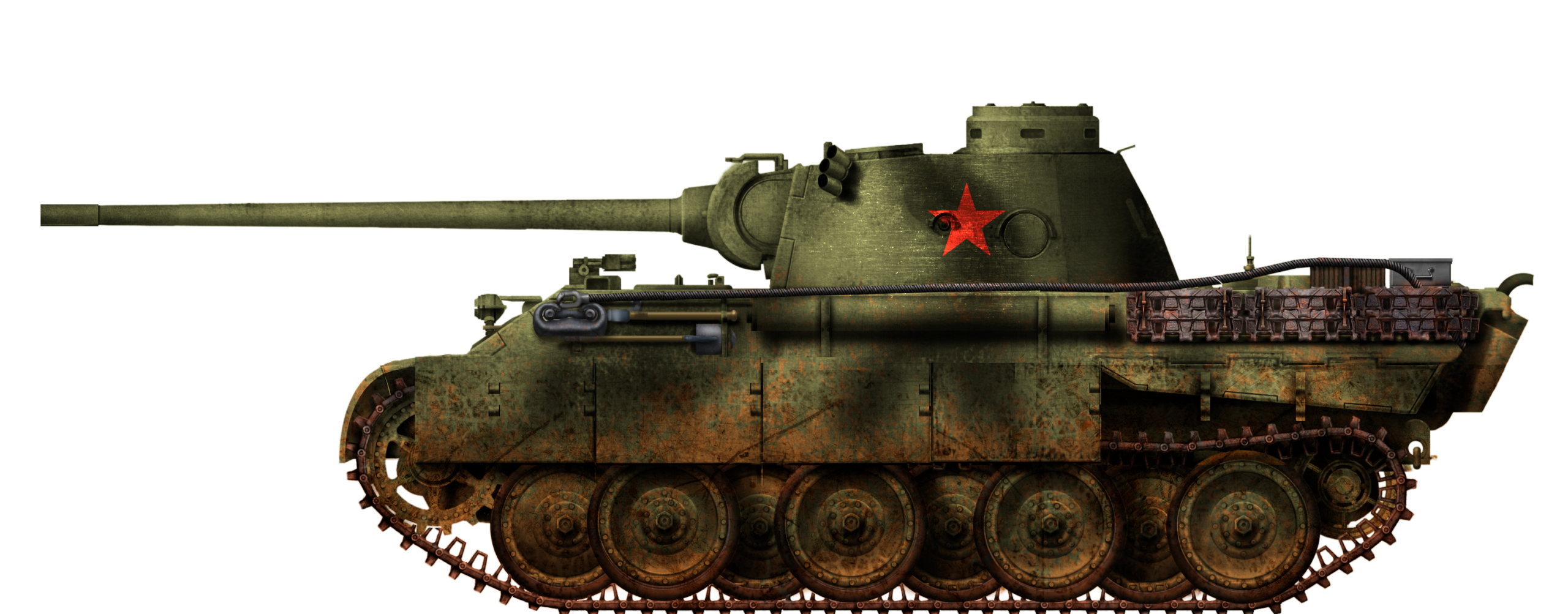
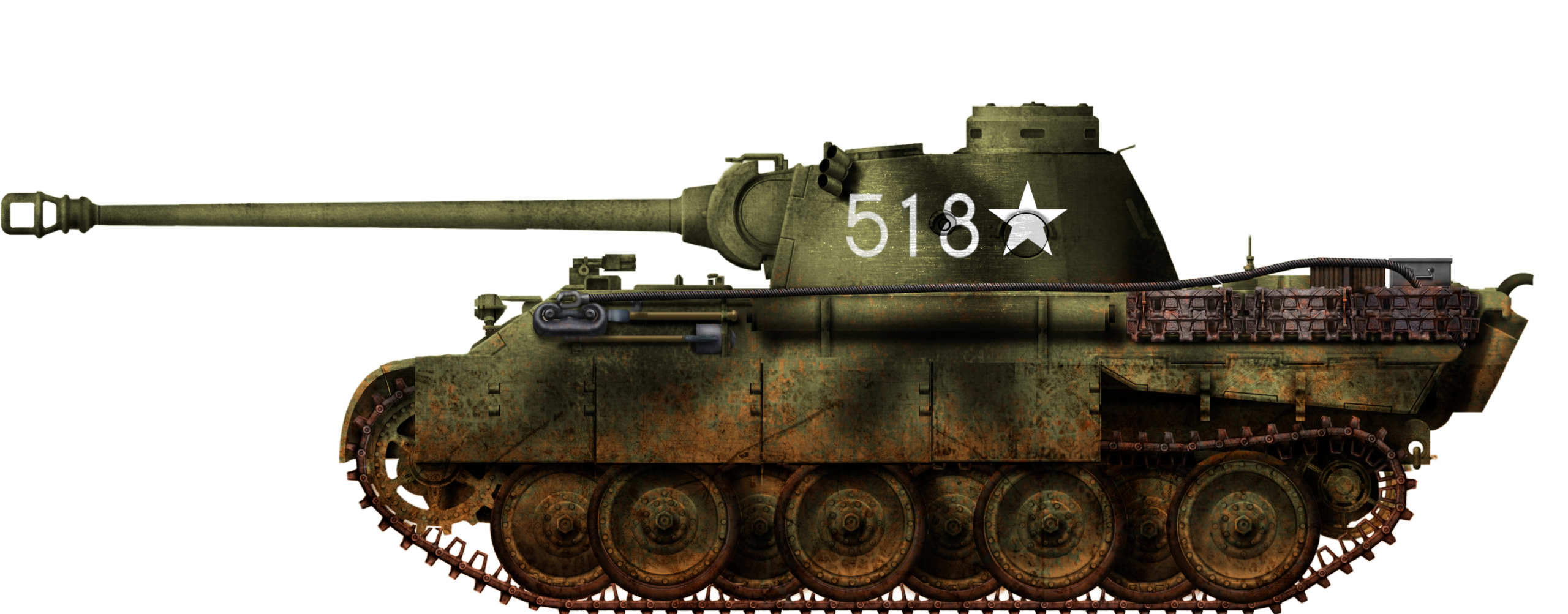
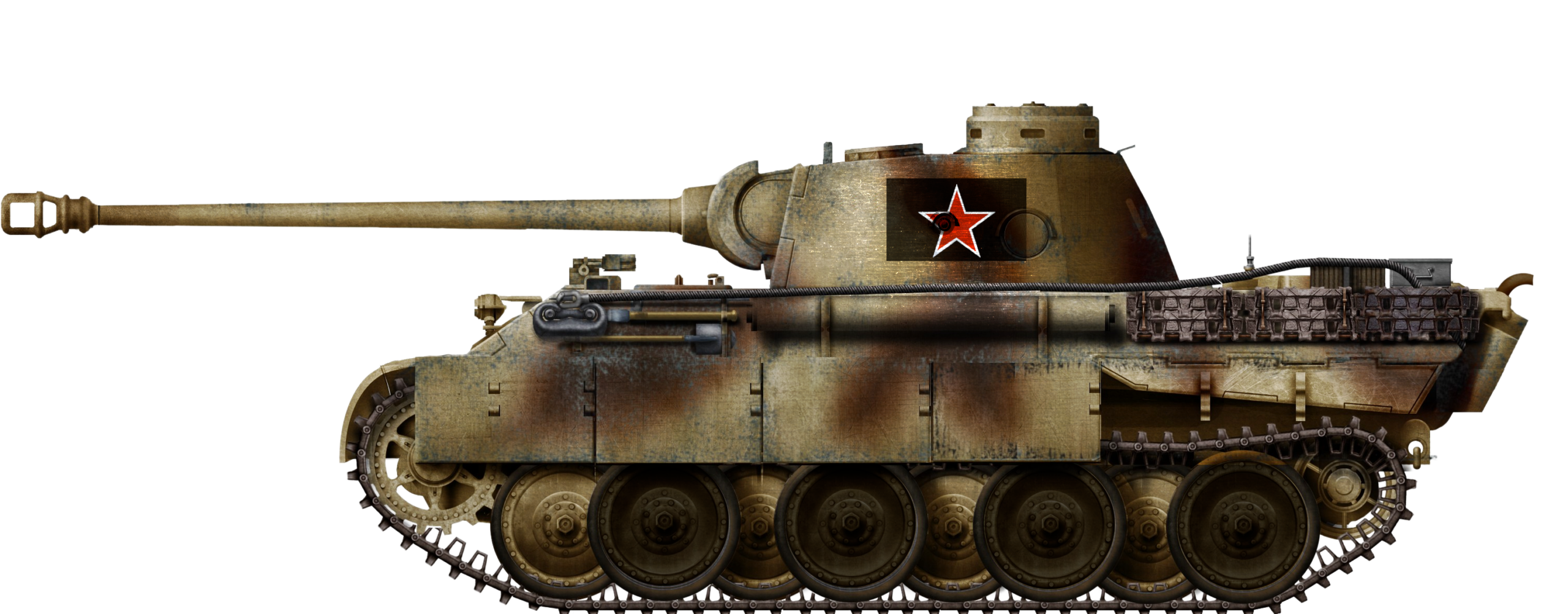
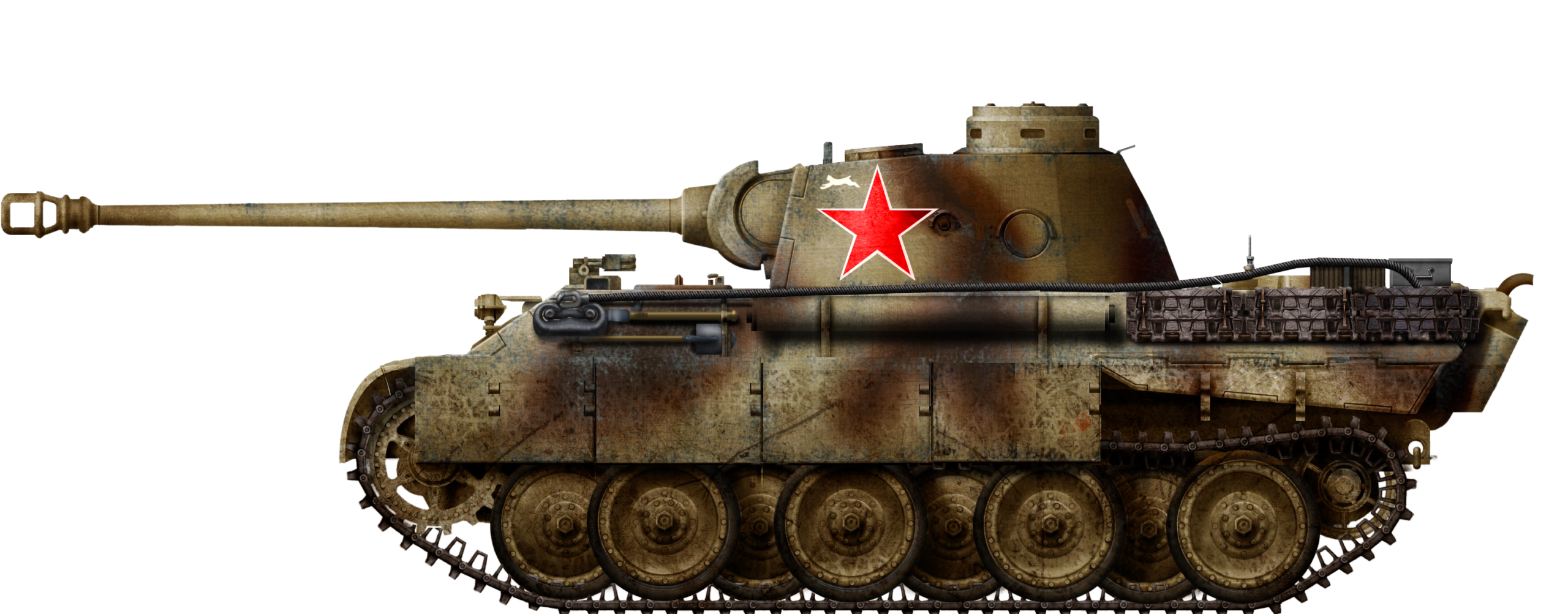
| T-V-85 specifications table | |
|---|---|
| Dimensions (L-W-H) | Length: 8.86 m Length (without gun): 6.866 m Width: 3.42 m Height: 2.917 m |
| Total weight, battle ready | 45.5 tonnes |
| Crew | 5 men (commander, gunner, loader, radio operator, and driver) |
| Propulsion | Water-cooled, gasoline Maybach HL 230 P30 V12 motor producing 600 hp at 2500 rpm coupled to a ZF A.K.7/200 transmission |
| Max speed | 46 km/h (28.6 mph) |
| Range (road) | On road: 200 km Cross-country: 100 km |
| Primary Armament | 85 mm ZiS-S-53 |
| Elevation Arc | -8°/+18° (frontal part), -4°/+18° (rear part) |
| Secondary Armament | 2 x 7.62 mm DT |
| Hull Armor | 85 mm (55°) upper frontal 65 mm (55°) lower frontal 50 mm (29°) upper side 40 (vertically flat) lower side 40 mm (30°) rear 40-15 mm (horizontally flat) roof 17 mm (horizontally flat) engine deck 30 mm (horizontally flat) frontward belly 17 mm (horizontally flat) rearward belly 17 mm (horizontally flat) pannier |
| Turret armor | 110 mm (10°) frontal 45 mm (25°) side and rear 30 mm roof |
| № built | 0, blueprints only; |
Special author’s thanks to his colleagues: Andrej Sinyukovich and Pablo Escobar.
Sources
Central Archive of the Ministry of Defense of the Russian Federation, 81-12038-775;
Russian State Archive of Film and Photo Documents;
M.A. Svirin, “Artillerijskoe vooruzhenie sovetskih tankov 1940-1945”;
http://wio.ru/tank/capt/capt-ru.htm;
http://armchairgeneral.com/rkkaww2//galleries/axiscaptured/axiscaptured_tanks_img.htm;
https://vpk-news.ru/articles/57834;
https://pikabu.ru/story/krasnaya_pantera_kak_sovetskie_tankistyi_otzhali_u_nemtsev_tank_7473239;
https://shrott.ru/news/88/;
https://topwar.ru/179167-ispolzovanie-trofejnyh-panter-i-tigrov-na-zavershajuschem-jetape-velikoj-otechestvennoj-vojny.html;
https://zen.yandex.ru/media/id/5cd1d04c9daa6300b389ab55/soviet-army-soldiers-inspect-the-destroyed-german-panther-tank-834-5fdea3a23713a37b86ba235b;
https://tanks-encyclopedia.com/ww2/germany/panzer-v_panther.php;
Pablo Escobar’s gun parameters table;

